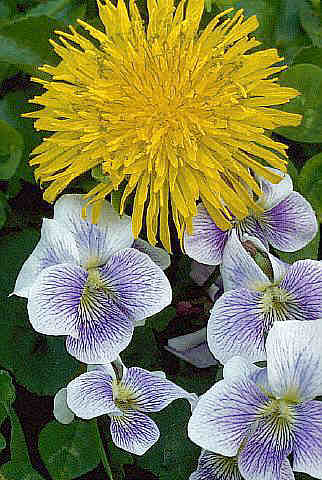Some short time ago, a lively discussion
developed on the OneList Sweet Violets Forum (www.onelist.com)
concerning the merits or otherwise of wild violets that appear in lawns and gardens. To some of the
participants of this forum, these wild violets were a nuisance, and needed to be eradicated. Why?
Because these violets had the audacity to grow amongst the perfect greensward of the lawn or perhaps these wild
violets were deemed inferior to the cultivated forms we actively discuss on this forum.
| |
|
|
 |
|
Dandelion
& Violets
|
|
| |
Both forms of the violet deserve equal
status and should be grown side by side to increase the available range of violets for the enthusiast.
However, we do not always see this. In order to explain the importance
of both types of violets we will take a lightening sprint through the history of violets.
Violets have been a revered flower for thousands of
years. In fact, they are one of the trinity of flowers along with the Rose and the Lily, and one of the earliest
written accounts of the violet and its cultivation comes from Ancient Greece, where it is said violets were cultivated in
plantations at Attica (outside Athens) around 400 B.C. The Romans also cultivated violets. They made violet
wine and used them in a variety of ceremonies, as did many of the civilizations throughout history. Until fairly
recently, all of these cultivated violets were gathered from the wild, and I suspect they were little different from their
native cousins.
By the 18th century all this was to change.
A group of market gardeners in France realized that the gathering of violets from woodland and hedgerow was potentially
a big money maker and so it was that around 1755 the first “nurseries” for the violet were set up with wild stocks.
Over the next few years these early entrepreneurs quickly realized that selection was the key to success and ‘Quatre
Saisons was introduced as the first cultivated violet starting a race throughout Europe
and later, North America. These gardeners bred bigger and better violets, and the heyday of the violets lasted for
nearly 200 years fueling a massive cut flower, perfume and confectionery industry that spread throughout the world.
The moral of this tale is that we need to respect
the value of both forms of violet. For those who actively collect violets and wish to expand the available
range of cultivars, wild violets are a necessity. They are used as a stock of genetic material to refresh and
renew cultivated violets for the next generation of violet growers, our children.